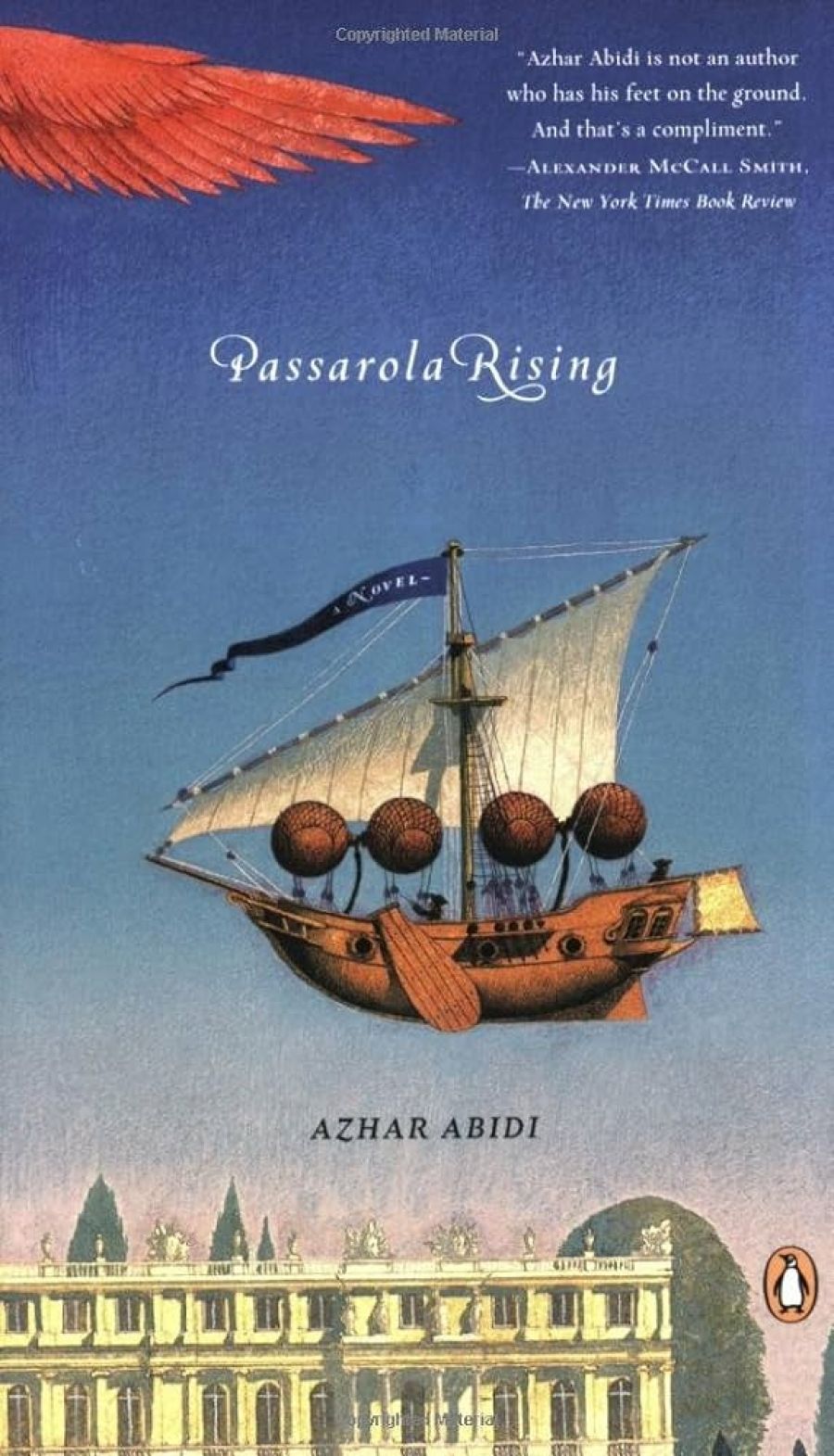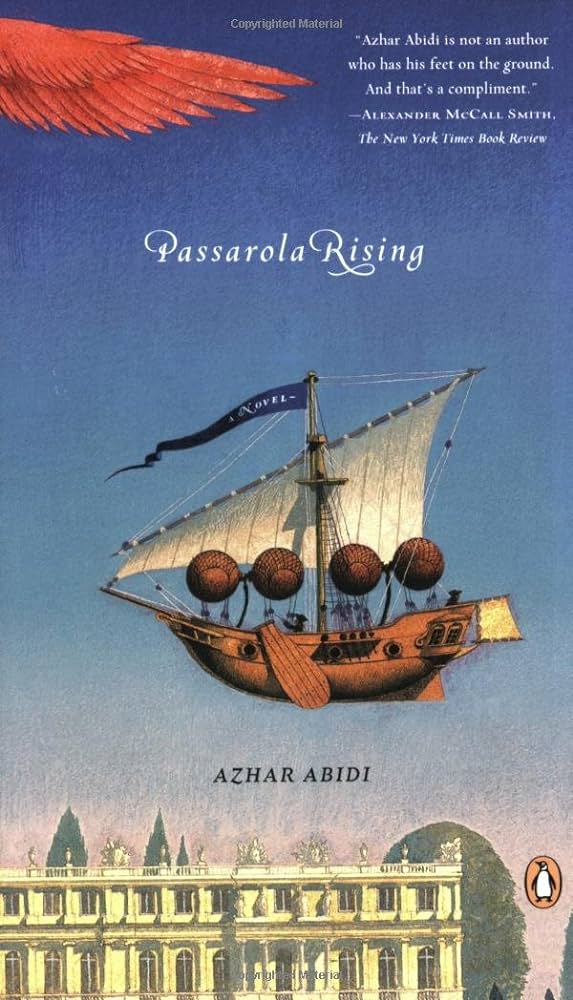
- Free Article: No
- Contents Category: Fiction
- Review Article: Yes
- Article Title: Getting high
- Online Only: No
- Custom Highlight Text:
In 1685, in São Paulo, Brazil, a boy was born called Bartolomeu Lourenço de Gusmão. Sent north to Bahia to study with the Jesuits, who had constructed, in the steep-cliffed port of Salvador, an amazing ‘levador’ capable of hauling goods and people from ground-level to the heights above, Bartolomeu learned as much about physics as theology. Finding the fathers’ dedication to higher things, both spiritual and material, immensely attractive, Bartolomeu became a priest who dreamed of building not just a hundred-metre lift, but the first vessel capable of sailing through the heavens. The ambition stayed with him even in Portugal.
- Book 1 Title: Passarola Rising
- Book 1 Biblio: Viking, $29.95 pb, 244 pp
- Book 1 Cover Small (400 x 600):

- Book 1 Cover (800 x 1200):

In modern Pakistan lived a boy called Azhar Abidi, who similarly grew up to embrace a double vocation. Not only an engineer with an MBA, he also wanted to write, to construct out of a fabric of fact fabulous yarns about flying. These ideas accompanied him to Melbourne. One of his tales was a scrupulously referenced essay on the history of the flying carpet – not, after all, a mythical object, but an early and successful experiment in aviation! The essay was published by the journal Meanjin, whose editor, Ian Britain, enquired about any other gems lying in the author’s drawer. Abidi owned that on top of two manuscripts sat several rejection slips, one of which regretted that this writing was too beautiful to be published in Australia. With a little help from Britain, it found favour with an American agent.
The novel called Passarola Rising took off with Penguin, which was semi-appropriate given that the airship’s name comes from the Portuguese word for bird (pássaro). And what a voyage of the imagination it is, a high-flying blend of fantasy, science and unprecedented adventure. Father Bartolomeu, having long abandoned the cassock, is joined in Lisbon by his younger brother Alexandre, enlisted to help Bartolomeu realise his dream of a vessel that will fly above the land and the sea. Bartolomeu is enthusiastically supported by the quirky king of Portugal, but vengefully opposed by Cardinal Conti, representative not only of the church but also of the Inquisition.
Bartolomeu’s designs for the Passarola show Alexandre an ordinary ship with a hull, two masts and three sails – except that above the deck hang four large copper spheres. Following a brief exposition of nautical physics and some discussion of vacuum-pumps and ballast not quite penetrable for the ordinary reader, the brothers spend a long year secretly sawing and hammering.
The description of the maiden flight of the Passarola is the first of several passages that bring intense pleasure; you feel airborne yourself, looking down on the gleaming tops of clouds, flying skilfully through flocks of migrating birds, observing the ever-changing hues of the sky and the variable coolness of the air, according to the ship’s altitude. When night fell, Alexandre would see a sky ‘littered with galaxies that glowed as if they had been washed in phosphorous. Comets tore through the void, burning bright like fireflies before vanishing into the inky blue.’ When their senses were sated or their muscles exhausted, one or other brother would rest below deck, in the small domestic space that was their only refuge from the overwhelming brilliance of the universe.
This is a picaresque tale driven by the four winds rather than by any great degree of plot, but Alexandre does set off certain events by sneaking aloft in the Passarola with a pretty girl he hopes to impress. The cardinal turns the prank to his own advantage, and the brothers are obliged to take off in a hurry, shooting with their pistols at the harrying earthbound soldiers, who soon dwindle away to ineffectual ants. Landing near Paris after several days in the air, the duo is royally entertained by Voltaire, until the king of France sets them a task. They are to rescue his father-in-law, the exiled Polish king, and help him recover his throne. The venture is stymied by hostile Russians, and the airship severely damaged; but the king pays for its repair in order to persuade Bartolomeu to undertake a scientific expedition determining whether or not the earth is flat at the poles.
This adventure is too hazardous and dramatic to be given the disservice of a summary. So harsh is it in fact that it shifts the emphasis from event to character, the hidden but significant differences between the two brothers emerging more intractably when Alexandre falls ill from the polar cold. In his delirium, he sees wondrous cities in the clouds and a huge bird with the face of a woman; in moments of consciousness, he becomes desperately nostalgic for normal life. Bartololmeu, ascetic and obsessed yet wise in human understanding, advises Alex to leave the Passarola as soon as they return to Europe. He himself never will; his destiny is inextricably linked to his vessel. Alex returns to São Paulo to visit his ageing parents, in the end marrying, settling, and fathering an adored son. But when he hears that Bartolomeu has been sent by the French king to explore Terra Australis, the longing for adventure stirs in him again, alongside a feeling of great emptiness. He frets that his hankering for comfort prevented him from living a fuller life. In compensation, he writes down the airy exploits of the Passarola, in a novel which, like Shelley’s skylark, ‘singing still dost soar and soaring ever singest’.


Comments powered by CComment